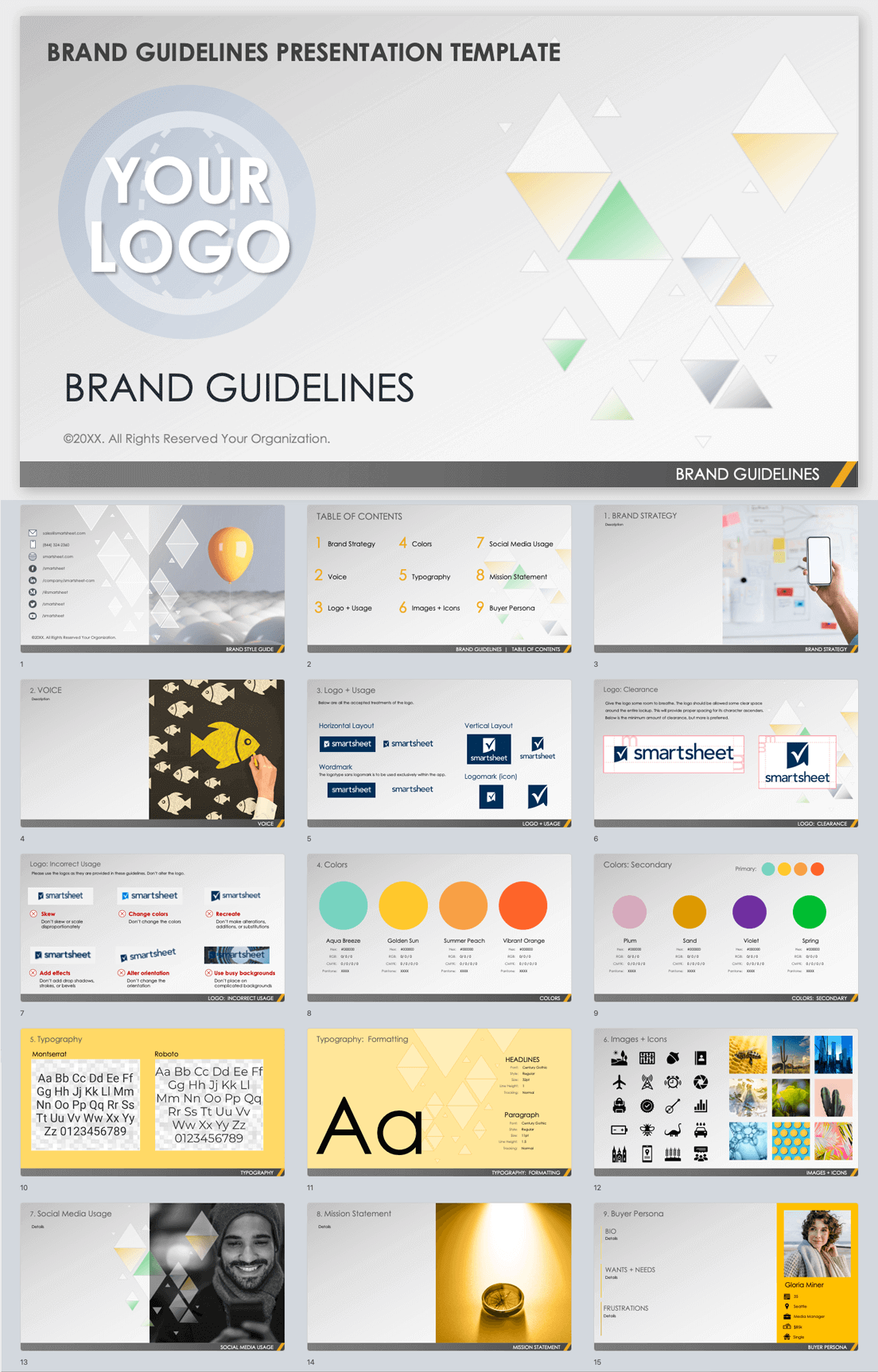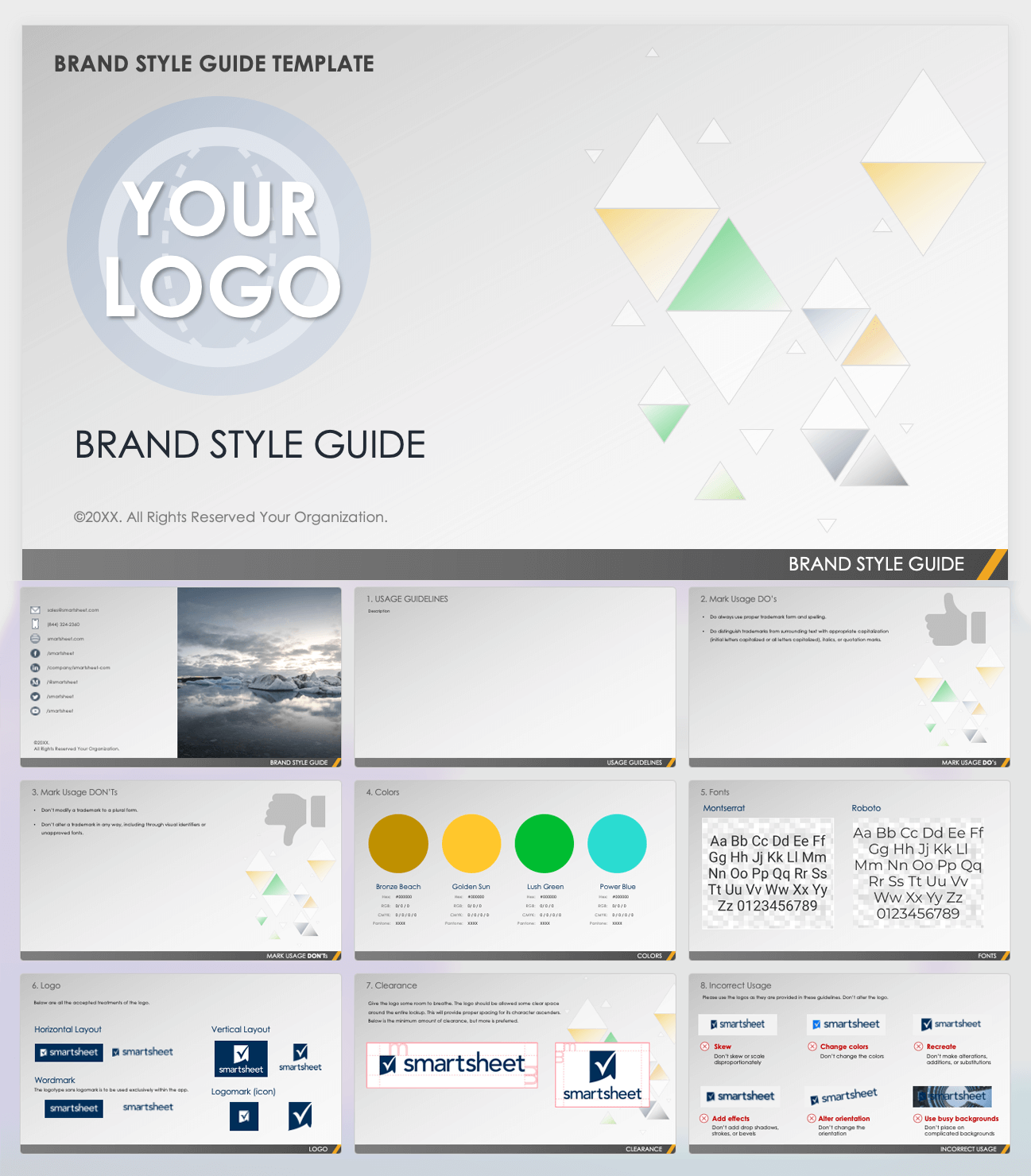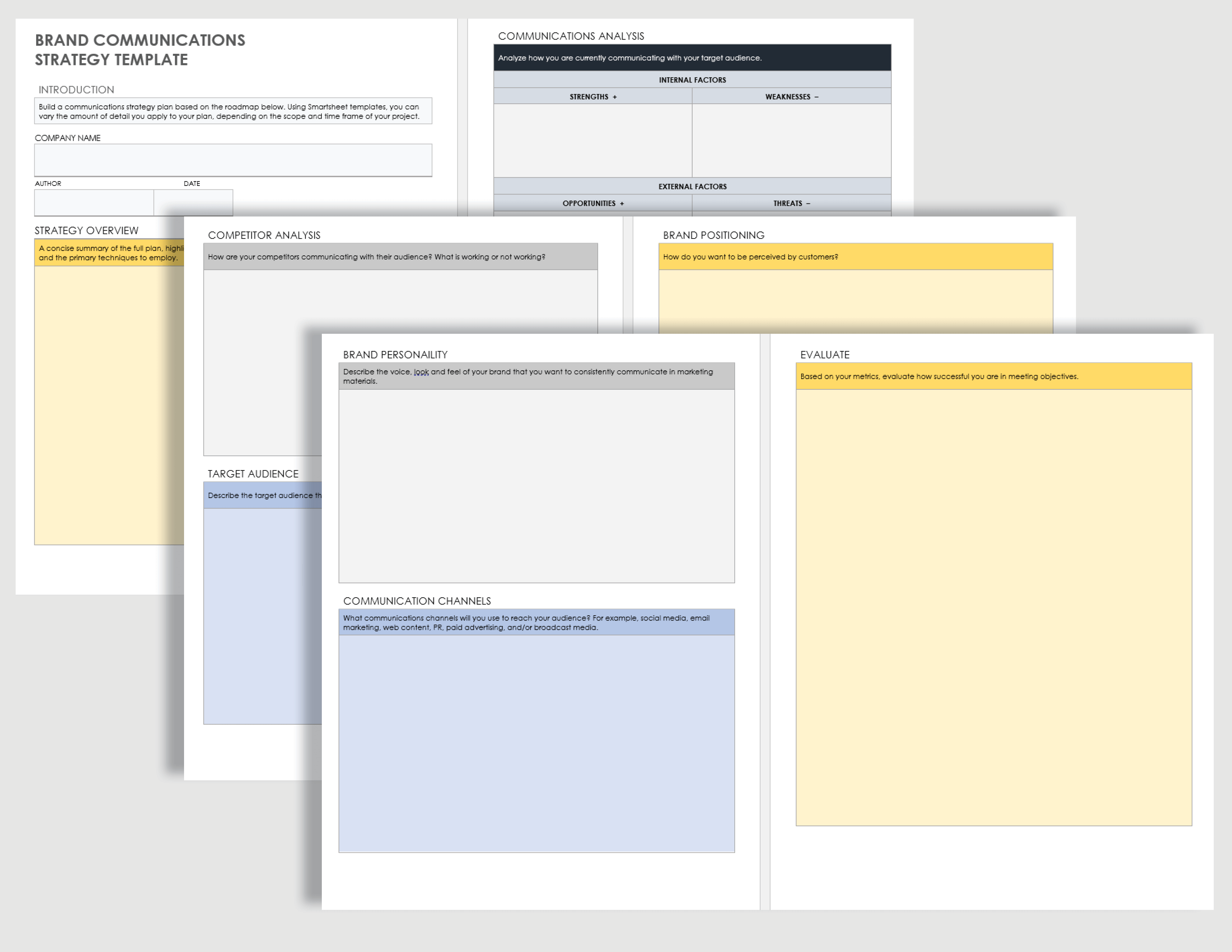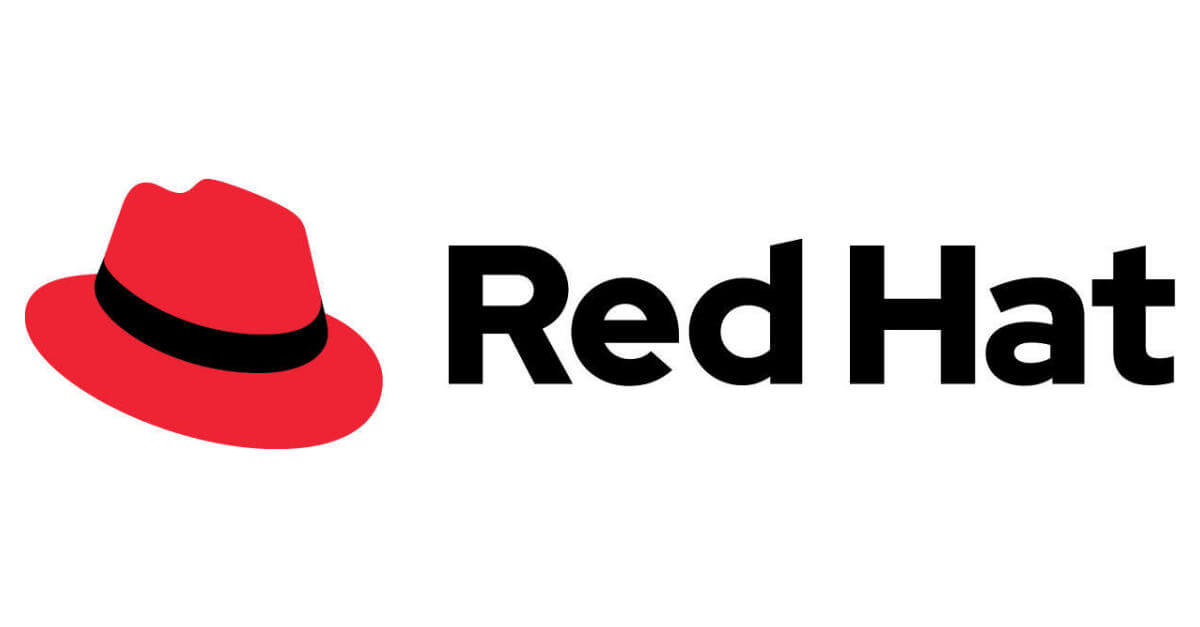What Is Brand Compliance?
Brand compliance is the adherence to established brand guidelines across all channels. Every customer touchpoint should reflect your brand’s personality and unique value. This includes your brand’s visuals, wording, tone, and overall approach to customer messaging. Compliance unifies your brand’s voice and amplifies its power.
“We've all heard — or even used — these words: the brand police,” says Cari Jaquet, who has served as Chief Marketing Officer at multiple IT SaaS companies. “That term conjures up people who are unnecessarily rigid, but being responsible for a company's brand comes with significant responsibility. Far from being pedantic, they have to make sure every touchpoint aligns with the brand's core values and visual identity. This can often be challenging, especially in larger organizations where employees don't know how they might unknowingly dilute the brand’s power and purpose.”

Why Brand Compliance Is Important
Brand compliance is crucial to harnessing your message, building brand recognition and trust, and improving marketing effectiveness. Ultimately, brand compliance helps you compete and improves your bottom line. It can also help you stay out of legal trouble.
“I would say if there's one reason you absolutely need to ensure brand compliance, it’s to create consistency and trust in your brand,” says Gayle Kalvert, the Founder and CEO of Creo Collective, a group of experienced B2B tech marketers who augment clients’ marketing teams.
“There are other reasons why brand compliance is important, like putting a stake in the ground as far as your market position,” Kalvert says. “There are legal and ethical standards that you really need to make sure you adhere to in a lot of industries. So having a very clear brand guide for everyone creating anything related to your brand to ensure they're compliant is critically important. You don't want to make any missteps that could cause legal issues.”
Here’s a list of key items that demonstrate the importance of brand compliance:
- Consistency and Quality: Brand compliance helps maintain consistency across all customer touchpoints — from graphics and imagery to the tone of marketing materials. This consistency produces higher-quality work and makes it easier for customers to recognize and engage with your brand. Don’t muddy the waters with messaging that distracts from your brand’s integrity and values.
- Brand Recognition and Loyalty: Consistent branding and messaging create a memorable customer experience, which can lead to repeat business and stronger customer relationships.
- Improved Marketing Effectiveness and ROI: Adhering to established brand guidelines and best practices can help you better connect with your target audience and achieve your business objectives. It creates brand equity, or the value your company derives from its brand.
- Legal Protections: Brand compliance also helps your organization adhere to relevant laws and regulations, protecting you from legal risks like trademark infringement.
- Mitigating Risks: Consistent brand compliance allows you to control the narrative around your brand and mitigate any negative press or internal crises that may arise. It helps you present a unified, credible image to customers and the media.
- Enhanced SEO: Maintaining brand compliance, including well-written content that incorporates keywords naturally, can improve your search engine optimization (SEO) and make your content more discoverable online.
Jaquet adds that brand compliance is important because it comprises so many elements that affect customer perceptions.
“Brand compliance doesn't just mean using the same logos, taglines, colors and graphics,” Jaquet says. “It also means making decisions that reflect the brand values and tone. Every communication and every business process should be informed by the brand, making everyone in the organization a steward of the brand. When customers experience consistent branding, it reinforces their understanding of what your brand stands for, making them more likely to trust and choose your products or services over competitors.”
Steps to Build Brand Compliance
Brand compliance starts with creating your brand guidelines. This document clearly defines how your brand should be presented. Next, you’ll create a governance policy, select brand compliance software, and develop processes. Finally, train the team, implement the program, and adjust based on results.
“Making sure the brand is easy to understand and adopt is crucial,” Jaquet says. “Often, brand components are designed to be elegant and sophisticated, but this can lead to practical challenges for those outside the creative department who need to implement them daily. To address this, it’s essential that the brand’s visual elements, such as the logo, are straightforward to use in real-world applications and that tools, such as iconography, graphics, and templates, are easily accessible and usable. Training plays a significant role in this, but the fundamental design of the brand elements should facilitate easy adoption.”
Kalvert says you can keep things simple if you’re just starting with brand compliance.
“I always tell people to start small,” Kalvert says. “You don't have to hire an agency to embark on a huge brand compliance program. Start an editorial guide, which literally can be as easy as starting to track your preferences in writing.”
Here are the specific steps to start a brand compliance program. (Note that we have a separate section below on how to improve your existing brand compliance.)
1. Define Brand Guidelines
The first step is to create comprehensive brand guidelines. Also called a brand style guide or a brand dictionary, this document should include details on logo usage, color palettes, typography, imagery, voice, and tone. The guidelines should also cover how these elements should be used in various formats, including digital, print, and merchandise.
Brand guidelines may also outline important details about your organization’s mission, brand positioning, messaging, and visual identity. For additional guidance, see this comprehensive guide to brand positioning.
Follow these three steps to develop your brand guidelines:
Determine the Format: Before you can create your brand guidelines, you’ll need to decide on a format. These free, downloadable brand guideline templates are available in Microsoft Word, PowerPoint, Google Docs, Slides, and Adobe PDF. Whatever format you choose, make sure it’s easily accessible to internal employees, external partners, and any other parties who will need access.
For example, this template is a perfect option for most brand guideline presentations:
Download a Brand Guideline Presentation Template for
PowerPoint | Google Slides
This template includes every slide you’ll need to create a detailed brand guideline, including voice, logo and logo usage, colors, typography, and more. For more options like these, check out these free brand presentation templates.
- Define the Scope: Next, define the scope of your guidelines to ensure you cover all touchpoints. What are the most important elements of your brand that are essential for all team members to understand? Consider the following components before drafting your guidelines:
- Brand Purpose and History: This section includes your brand’s mission, story, and values.
- Brand Messaging: This section includes your brand’s voice, tone, and messaging pillars. When defining your messaging pillars, include important elements such as your brand’s identity, its purpose, and the perception it’s trying to maintain.
“Part of your brand is your key messaging,” Kalvert says. “What are your company’s key messages? That is something you can work with your marketing team internally to do — and doing market research and then documenting what those key messages are.” - Value Propositions: This section includes your target audience, selling points, and competitive advantages. In other words, what is it about your organization that makes it stand out, and how can you convey that in your messaging? Refer to any brand positioning documents you have, such as a brand positioning statement.
- Visual Branding: This section includes your brand colors, logo, typography, web design, imagery, and other visual elements essential to your organization.
“What is your visual brand? What are your colors? What are your proportions?” says Kalvert. “Where do you put the logo? Are you right aligned? Left aligned? All of these things seem like small details, but when they're not consistent, they really do cause confusion and can dilute the value and the experience of your brand.”
Write Your Brand Guidelines: Now that you’ve determined the scope of your brand guidelines, you’re ready to write. When drafting your guidelines, make sure every element is clear and easy to digest. Use examples and visual elements to illustrate information whenever possible. If a new employee or external partner knew nothing about your brand, would they be able to read your brand guidelines and understand the message you’re trying to convey? If someone has a question about your branding, it should be answered within your brand guidelines.
Be sure to touch on both digital (e.g., social media, email, newsletters, and blogs) and print (e.g., packaging, flyers, billboards, and signs) standards in your guidelines. Note that some companies create two documents: an editorial style guide for wording and a brand design guide for visuals.
Whatever you choose, make sure any supporting assets and files — like your brand logo, fonts, or other branding templates — are stored in a centralized location so they’re easy to access.
Download a Brand Style Guide Template for
Microsoft Word | PowerPoint | Google Docs | Google Slides
This editable template is the perfect solution for writing brand guidelines. Its pre-formatted sections include space to communicate usage guidelines, colors, fonts, logos, incorrect usage, clearance, and more.
Find everything you need to create consistent, impactful brand guidelines in this article on brand style guides.
Once you’ve clearly outlined your brand standards, creating brand assets will become easier. Your team will know exactly what guidelines to follow to ensure they’re staying compliant with your brand messaging.
2. Ensure Buy-In from Executives and Stakeholders
For brand compliance to work, you need buy-in across an organization. Otherwise, different departments and individuals may operate in silos and thwart compliance.
“Brand compliance must be a top-down initiative,” Jaquet says. “It's not okay for only the marketing team to champion brand consistency. Every member of the executive team needs to endorse and advocate for the importance of maintaining a cohesive brand, particularly during challenging times.”
As an example, she talks about what can happen with mergers and acquisitions. “When a new company is brought into the fold, there’s often resistance to adopting a new brand, as employees may feel attached to their original identity,” Jaquet says. “Without strong leadership enforcing brand compliance, rogue behavior can undermine efforts to unify the brand post-merger. Active and consistent participation from the top is essential to set the tone and uphold the brand across all levels of the organization.”
3. Enforce Governance Policies
Establishing and enforcing governance policies can help ensure you stay compliant and adhere to brand standards.
Brand governance refers to an organization’s actions and efforts to guarantee that the brand is being presented correctly — both internally and externally. Your brand guidelines and governance policies go hand in hand.
For example, you may have policies regarding logo usage, access to assets, and trademark and copyright rules. You should also have a detailed plan for enforcing brand governance policies and handling noncompliance.
“We treat noncompliance as a learning opportunity rather than a failure,” says Marshal Davis, President of Ascendly Capital. “The person responsible has to dissect what went wrong in a team meeting, turning it into a lesson for everyone. This approach ensures that we're always improving and that the same mistake doesn't happen twice.”
For more help with this step, see this article on content governance, which features expert advice and free, downloadable templates.
4. Use Brand Compliance Software
Brand compliance software streamlines your organization's processes; it can house your brand guidelines and handle approval of assets, workflow automation, user controls, and more. Adopting brand compliance software will ensure your organization consistently adheres to brand guidelines.
Here are some of the top benefits of utilizing brand compliance software:
- Customization: Most software feature customization options to change the look and feel of the dashboard and assets to align with your branding.
- Accessibility: Brand compliance software gives easy access to your organization's brand guidelines, assets, and compliance information, providing an all-in-one database for content and brand assets.
- Integration: Brand compliance software can integrate with other systems and tools, which can streamline team workflows.
- Reporting: Reporting features can provide insight into brand compliance performance and metrics so your organization can stay on track and identify areas for improvement.
- Cost: Automating tasks with brand compliance software can reduce costs associated with manual tasks.
- Support: Many brand compliance software solutions offer customer support and training so organizations can effectively implement and use the software.
5. Centralize a Compliant Content Repository
Consolidating all of your digital assets into one location ensures authorized team members have access to everything they need. A digital asset manager (DAM) can centralize your organization’s digital files and create a space to collaborate and provide feedback throughout the content lifecycle.
A DAM also makes it easy for users to search for the content they need by keeping everything organized according to your organization’s taxonomy. All communication, including feedback and approval, should be made within this platform.
6. Set Up Authorized Access
Once you have your assets centralized, you’ll want to set up user access. User access ensures that assets are accessible only to authorized users. This makes it easy to control who can view, edit, delete, or download assets. You can also set up limited permissions for external users — like clients, freelancers, and shareholders — that allow them to access and approve files if needed.
Setting up authorized access can also protect sensitive assets from getting into the wrong hands. User access typically follows a hierarchical structure so your DAM administrator can restrict access to sensitive content. To add an extra layer of protection, set up password requirements and two-factor authentication.
7. Monitor Asset Changes and Versions
Brand compliance software should allow you to see all of an asset's history — including feedback, edits, approvals, and versions. These records are important for maintaining brand compliance.
Here are the top reasons to monitor asset changes using brand compliance software:
- Creating an Audit Trail: Having a record of changes and versions of assets creates an audit trail essential for maintaining compliance. This helps your organization prove you’re adhering to brand standards.
- Reducing Future Errors: Teams can easily track and review changes, reducing the risk of future errors.
- Maintaining Consistency: Tracking changes can help maintain a consistent brand image by ensuring all brand assets follow your organization’s guidelines.
- Managing Versions: A record of asset versions ensures all team members are using the most recent version, reducing the chance of using outdated and incorrect materials. Your team can also refer to old versions if needed.
Learn more about how to monitor asset changes in this guide to effective brand asset management.
8. Consider Approval Signatures
Some assets may need approval from higher-ups, such as CEOs, founders, and managers. This extra layer of approval helps ensure brand compliance.
Collect electronic signatures through your brand compliance software to streamline the approvals process.
9. Develop and Automate Workflows
Content lifecycles involve many review and approval stages. Secure and automated workflows can help streamline the brand compliance process and ensure you’re covering all your bases.
Automated workflows allow you to set rules for file access and approvals at each stage to keep your process consistent.
10. Train the Team to Maintain Brand Compliance
Education is essential to brand compliance. Be sure to train new and existing employees and partners to ensure that they understand and can implement your brand communications strategy and overall brand strategy. Prioritize training updates whenever you make significant changes.
Regular training also allows team members to give valuable feedback on your organization’s brand guidelines.
Download a Brand Communication Strategy Template for
Excel
|
Microsoft Word
Try this template when you need a structured approach to creating a detailed and effective brand communication strategy. The template guides you through communications analysis, competitor analysis, brand position, brand personality, and more.
For even more helpful resources, see this collection of free, customizable brand strategy templates.
11. Regularly Review and Update the Brand Guidelines
As a brand evolves, so should its guidelines. Schedule annual or bi-annual reviews involving key stakeholders from marketing, legal, and product development. Determine if any sections need updates due to changes in branding strategy, market positioning, or industry regulations. Implement changes and clearly communicate updates to all relevant parties.
12. Create a Feedback Mechanism
Establish feedback channels for internal and external stakeholders, such as regular surveys or dedicated email addresses. Regularly review this feedback to identify common challenges or areas for improvement, and use it to inform updates to the brand guidelines.
13. Conduct Random Compliance Audits and Enforce Consequences
Develop an audit schedule that includes random checks of brand assets and marketing materials across different channels. Use a checklist based on the brand guidelines to assess compliance. Report findings to management and address any non-compliance issues. Consider using third-party auditors for unbiased assessments.
In addition to auditing, it is important to establish and enforce consequences for non-compliance. While education and reminders should be the first step, consistent failures in compliance may require stricter measures.
14. Establish KPIs and Reports
Identify key performance indicators (KPIs) for brand compliance, such as the rate of compliance, incidents of non-compliance, and employee awareness. Regularly collect data on these KPIs, compile them into reports, and share them with senior management to inform future brand compliance efforts.
15. Integrate Brand Guidelines with Other Corporate Policies
Review other corporate policies to identify synergies and potential conflicts. Align the brand guidelines with these policies to ensure cohesive enforcement across the organization, and facilitate joint training sessions to educate employees on how these integrated policies affect their roles.
Brand Compliance Starter Kit
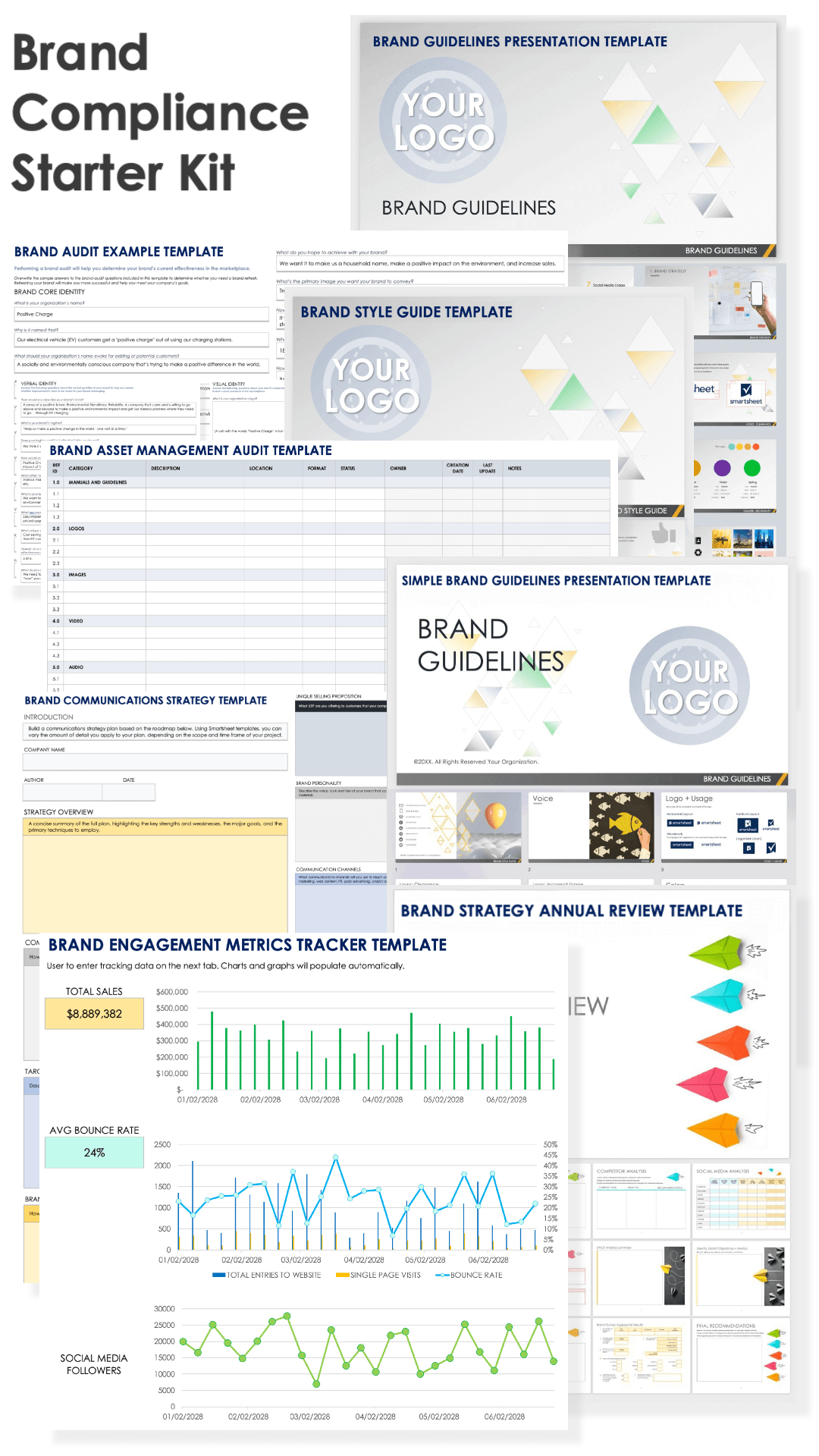
Download the Brand Compliance Starter Kit
This starter kit provides the materials you need to create or improve your brand compliance. Download the kit to access all the Microsoft Word, PowerPoint, and Excel templates. In this kit, you’ll find:
- A brand guidelines presentation template for PowerPoint to communicate all aspects of your branding, including your mission, strategy, voice, and visual assets.
- A simple brand guidelines template for PowerPoint to give a more concise presentation.
- A brand style guide template for PowerPoint , or Microsoft Word to standardize the look and feel of your brand.
- A brand audit template for Microsoft Word to organize and present your brand audit.
- A brand audit example template for Microsoft Word to learn from a sample brand audit.
- A brand asset management audit template for Excel to review and compare your existing assets, such as logos and images.
- A brand communication strategy template for Excel or Microsoft Word to outline your communication strategy.
- A brand engagement metrics tracker template for Excel to measure the impact of your brand compliance initiative.
- A brand strategy annual review template for Microsoft Word to assess progress.
How to Improve Your Existing Brand Compliance
To improve your brand compliance, start with a comprehensive review. That means you’ll conduct a brand audit, review workflows, and assess team training. Then, revamp as necessary to be more consistent and effective. From there, establish feedback loops, measure results, and keep iterating.
Here are the detailed steps to improve your brand compliance:
1. Conduct a Brand Audit
- Review existing brand assets, marketing materials, and content across channels to identify instances of non-compliance.
- Identify teams with inadequate training or resistance to brand guidelines.
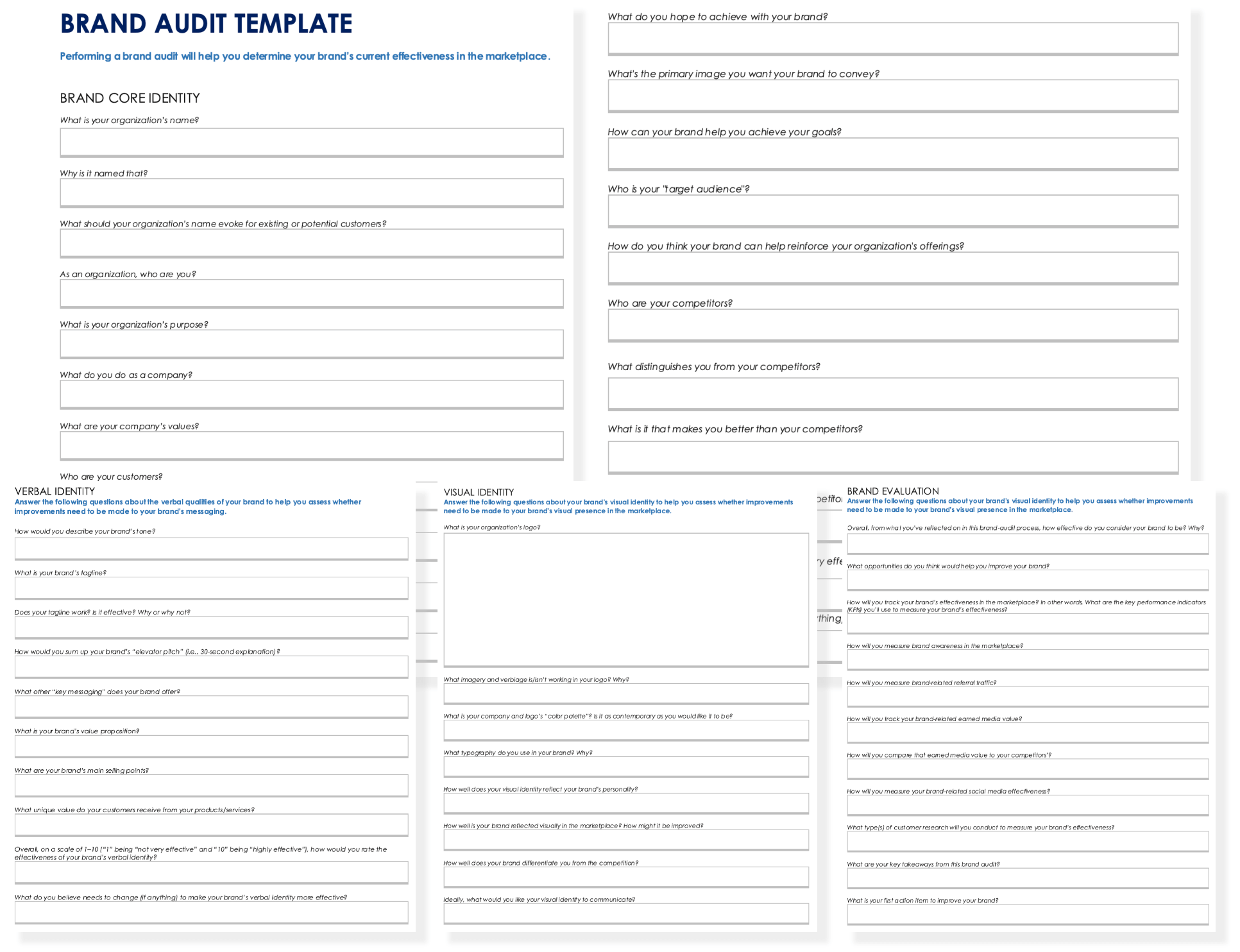
Download a Brand Audit Template for
Microsoft Word
or Google Docs
2. Assess and Adjust Compliance Workflows
- Establish a review and approval process for brand-related content.
- Require sign-offs from designated team members.
- Leverage brand compliance software to streamline workflows and enforce guidelines.
3. Evaluate Team Training
- Develop programs to educate employees on brand compliance and the proper use of brand assets.
- Ensure everyone understands the brand guidelines and their role in maintaining brand integrity.
- Consider gamifying the training to make it more engaging and effective.
“Consistent branding reinforces the company's values and mission internally, helping employees feel more connected to the brand,” Jaquet says. “This internal buy-in is crucial for delivering consistent customer experiences, as employees who believe in the brand are more likely to uphold its standards in their work and interactions with customers.”
4. Provide Creative Templates
Make it easier for teams to create on-brand content by providing pre-approved templates, design assets, and other tools that align with your brand guidelines.
5. Start a Feedback System
Set up channels for internal and external stakeholders to provide feedback on brand compliance issues. Use this feedback to identify common challenges and inform updates to your brand guidelines.
6. Establish a Brand Compliance Newsletter
Create a regular newsletter to share updates on brand guideline changes, highlight good examples of brand compliance, and educate employees on the importance of brand integrity.
7. Incentivize Brand Compliance
Recognize and reward employees who consistently demonstrate strong brand compliance. Consider incorporating brand compliance metrics into performance reviews and compensation. Celebrate successes and showcase positive examples to reinforce the importance of brand compliance.
8. Continue Random Spot Checks After the Audit
- Regularly review your existing brand assets, marketing materials, and content across all channels to identify instances of non-compliance.
- Conduct spot checks to ensure compliance.
9. Continuously Monitor and Iterate
- Regularly review brand compliance metrics and gather feedback from stakeholders.
- Identify areas for improvement and update brand guidelines to address evolving business needs and market changes.
- Communicate any changes to the brand guidelines and provide ongoing support to ensure successful implementation.
“To ensure brand compliance across all our projects, we’ve developed specific guidelines for each brand or product we manage,” says Marshal Davis. “Before any content or campaign is released, it goes through a hands-on review process involving multiple team members, ensuring that everything aligns seamlessly with the established brand guidelines.”
How to Monitor Your Brand Compliance
You can monitor your brand compliance with technical solutions that streamline the process. The two types are web-enabled, which require manual checks via online tools, and automated, which enforce guidelines automatically. Both help organizations maintain control over their brand identity across multiple platforms.
Web-enabled and automated brand compliance systems share these key functionalities:
- Real-Time Monitoring: Track brand compliance in real time and send alerts.
- Dashboard Overview: Use a dashboard to view compliance across channels.
- Reporting Tools: Monitor trends and problems with analytical tools.
- Access Control: Grant users different access levels.
However, there are key differences between web-enabled and automated compliance systems, which we review below.
Web-Enabled Brand Compliance Systems
Users access web-enabled brand compliance systems via browsers. They can integrate easily into existing workflows.
Here are some key features of web-enable compliance systems:
- Accessibility: Users can access these browser-based systems anywhere.
- Manual Oversight: These systems have automated alerts but often require more manual operations to respond to compliance issues.
- Integration with Online Assets: You can effectively monitor online brand assets like websites, social media, and digital marketing materials.
Automated Compliance Systems
Automated brand compliance systems use advanced algorithms and machine learning to enforce brand guidelines with minimal manual intervention.
These are some of the distinct features of automated compliance systems:
- Process Automation: These systems automatically detect compliance issues and sometimes resolve them without human intervention.
- Advanced Analytics: These systems use AI to reveal and predict problems and trends.
- Scalability: Automated systems are well-suited for larger organizations with extensive brand assets.
Both web-enabled and automated brand compliance systems provide essential tools for monitoring and maintaining brand integrity. The choice between them depends on the company’s needs, the desired automation level, and the complexity of the brand compliance.
Cost of Ineffective Brand Compliance
The cost of ineffective brand compliance is steep. It could result in weak marketing and sales, harming the company’s bottom line. It could confuse consumers and cause you to lose ground to competitors. It could also cause legal issues when teams violate trademarks or industry regulations.
“There are major implications from a legal and financial standpoint if you do not have clear guidelines, especially in highly regulated industries like health care, pharmaceuticals, and financial services,” Kalvert says. “So there are legal costs and there are lost opportunities, but the real concern is the ultimate price where companies can go out of business because of reputational damage from not having brand compliance.”
Jaquet also mentions the cascading effects of poor brand compliance. “Poor or sloppy brand management can lead to a fragmented brand image, which dilutes the brand's power,” Jaquet says. “Downstream, decreased trust and customer loyalty directly impact sales. To make matters worse, inconsistent branding can lead to legal issues, especially if improperly used logos or messages violate copyright or trademark regulations.”
Most broadly, ineffective brand compliance weakens your relationship with customers. “If you're inconsistent in the way your brand looks, how is anyone going to know what your brand is?” Kalvert says. “They don't know who they're engaging with and what kind of company it is.”
Let Smartsheet Streamline Your Brand Compliance Process
Empower your people to go above and beyond with a flexible platform designed to match the needs of your team — and adapt as those needs change.
The Smartsheet platform makes it easy to plan, capture, manage, and report on work from anywhere, helping your team be more effective and get more done. Report on key metrics and get real-time visibility into work as it happens with roll-up reports, dashboards, and automated workflows built to keep your team connected and informed.
When teams have clarity into the work getting done, there’s no telling how much more they can accomplish in the same amount of time. Try Smartsheet for free, today.

